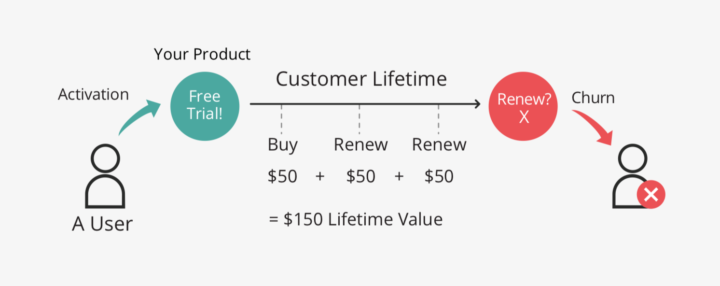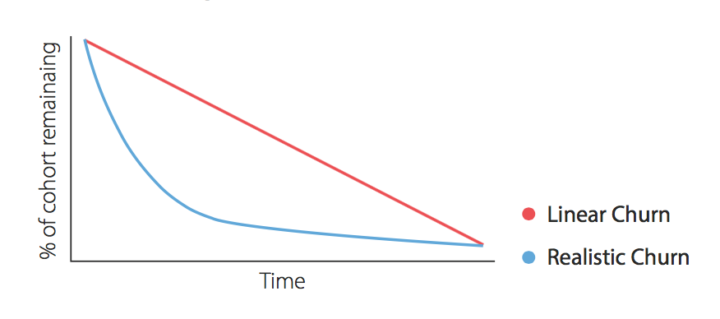Imagine being able to know the total revenue you’ll receive from a single customer on average — that’s the promise of customer lifetime value (LTV). It’s a valuable metric for assessing the health of a subscription business and making informed decisions about customer acquisition. However, a word of warning: it can be difficult to reliably estimate!
Definitions
Customer Lifetime Value (LTV) in SaaS is an estimate of the average total value of a customer, over their lifetime (from signup to churn).

💡 Gross Margin is the difference between revenue and COGS (cost of goods sold). This is typically very high in SaaS, e.g. >80%.

The dream: how we can use LTV
“LTV is a good indicator to segment customers and prospects to plan pursuit, nurture and coverage. However, it cannot gauge changing customer revenues and cost to serve over time, hence one cannot depend on LTV for long-term models to assume retention rates (loyalty rates) to also be stable over time.”
Arun Mani, Freshworks
Being able to estimate the complete lifetime value of a customer is a hugely powerful tool that is primarily used to control customer acquisition spend.
What does that mean?
If I know that customers will contribute $5k to my business on average over their lifetime, that tells me a lot about how much I can spend to acquire them. In fact, the general rule is that my customer acquisition cost (CAC) should be no higher than 1/3 of my LTV.
If my LTV is $5k and I have a reliable, repeatable way to acquire new customers for just $500, didn’t I just create a money-printing machine? Well, unfortunately it’s a little more complicated than that.
The reality
“Your LTV tells you how much you can spend to profitably acquire a customer. With accurate conversion rates, it also tells you how much you can spend to profitably acquire a free trial or landing page visitor. It isn’t very useful when you’re just getting started because the numbers it’s based on (ARPU, Churn) fluctuate significantly. Therefore it isn’t accurate.”
Andrew Rasmussen, Canny
It’s important to remember that LTV is always an estimate or projection of the future. That puts LTV in a very different category to metrics like churn rate or ARPA, which are all measurements of the past. Predicting the future is hard and there’s no perfect way to try and model the potential outcome for your customers, especially if you don’t have a lot of historical data to go on.
So based on this we need to temper our expectations a little bit — LTV can be a useful tool to roughly project total value from customers, and it can help us make some decisions and track progress.
“Often it is hard to define ‘value’ in terms of customer lifetime value. Is it solely the the amount of years that a customer is your client, with the total sum of MRR during those years. Or lies its lifetime value also in other, harder to quantify fields? Like evangelizing us on social media and conferences, trying out new products or sharing their data with us?”
Arun Mani, Freshworks
The simple formula assumes linear churn rate
This is never usually the case — most churn happens within the first 90 days of the customer lifetime, and tails off after this period. So you’d expect to see a curved chart when looking at a single cohort:

It also doesn’t account for expansion or negative churn
Cast your mind back to lesson three of this course: Churn. Here, we described negative churn as a state when “the revenue added from up-sells and expansion exceeds that of the revenue lost from churn and downgrades.” Negative churn is a highly desirable goal for any subscription business, and is a strong indicator of healthy growth through account expansion.
The problem with the basic LTV formula is that it only looks at customer churn rate, and doesn’t take into account any form of revenue expansion. This can lead to a prediction that’s far too optimistic.
A more advanced formula
“For subscription-based businesses who have negative churn (they expand revenue from retained customers at a greater rate than lost revenue from churn), you need new formulae to calculate LTV that includes both this expansion rate and churn. In addition, because you are modeling revenues that will occur far in the future, you will need to apply a discount rate to account for the risks and time value of money.”
David Skok, Matrix Ventures
To address some of the shortcomings of the widely-used simple formula, David Skok (Partner @ Matrix Ventures) presented a more sophisticated LTV formula:

It looks confusing, I know — but don’t panic! Let’s dig into it a little.
The two concepts added to this new formula are:
“K”, the discount factor
Which takes care of value reduction on all fronts. This includes the usual customer churn rate, but also “Discount Rate”. Discount rate accounts for both risk and reduced value of money over time, mentioned above. It’s a predefined annual rate of your choosing. Skok suggests a Discount Rate of 20-25% for pre-scale businesses or 10% for scale-stage businesses.
“G”, the expansion rate
Annual Growth rate for customers who haven’t churned. Aka: the business expansion rate of your existing customers. Which turns your negative MRR churn into a positive figure in the formula.
This advanced formula should result in a more realistic estimation of your business’s LTV. In the majority of cases it’s likely to be more pessimistic, except in the case of a really strong expansion rate.
The most important aspect of LTV
With all of the debate around the LTV and the the formula that’s used, it’s easy to forget one key aspect of measuring it: It generally doesn’t make sense for early-stage businesses. Due to the limitations outlined above, your efforts are better spent reducing churn, iterating on the product and getting qualitative feedback from customers. LTV is a metric that makes sense when you’re ready to tweak and optimize some of the growth levers in your business, before you really hit the gas and go for scale.
Resources and Further Reading
BASICS
ChartMogul Metrics: LTV — Breaks down both LTV formulae and includes an LTV calculator to try for yourself.
The Ultimate SaaS LTV Cheat Sheet — A free downloadable PDF containing everything you need to know on the topic.
DEEP CUTS
Actionable SaaS Metrics: Customer Lifetime Value (LTV) — This post helps make LTV actionable for your team.
SaaS Q&A: How do I calculate LTV when I have negative churn? — This post speaks for itself! If you have negative churn, you’ll want to look at this.
